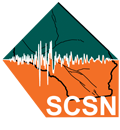Last updated June 8th, 2020
Event
- 03 Jun 2020 18:32:11 PDT, (35.615, -117.428), depth 8.4km.
- 17km S of Searles Valley, California
- This earthquake is an aftershock of the M7.1 Ridgecrest mainshock that occurred 11 months earlier, on July 5th 2019. The M7.1 earthquake broke a fault 50km long, and this M5.5 aftershock occurred at the southern end of the aftershock zone.
- This late aftershock is to be expected for a large sequence like this, even though the number of aftershocks has been decreasing over time (as expected). Over 40,000 aftershocks have been recorded in the 11 months since the mainshock. When tens of thousands of smaller earthquakes occur, the occurrence of a larger earthquake is not surprising, given the constant ratio of small to large events that we expect.
- Given the distribution of shaking shown in the ShakeMap the shaking in Trona was stronger than in Ridgecrest. Both regions suffered strong shaking in July 2019.
Aftershocks
- As of 07 Jun 2020, 09:44PM PDT, there have been 327 aftershocks recorded. 8 have been M≥3, and 35 M≥2. The largest was M4.3 (smallest M0.1).
- More aftershocks may be expected in the next few days, the largest expected is approximately 1 magnitude unit smaller than the mainshock. More M3 aftershocks are likely over the next few days, a M4 would not be surprising and another M5 is possible.
- There is a small chance (about 5%) that a larger quake could occur, with the likelihood decreasing over time.
Possible Foreshocks
- There were 20 events during the 3 days prior to the earthquake (within a 10 km radius).
- The largest was M2.3 (2020/06/01).
Historical Seismicity
- Since our records began in 1932 we’ve had 58 events of M4 or greater within 10km of today’s event.
- The largest historic event was M6.4 on 2019/07/04.
- The most recent historic event was M4.0 on 27 Apr 2020.
Faults
- CFM fault associations: most likely Eastern Little Lake fault (96%). Alternates: Not associated with a CFM modeled fault (3%), Other CFM faults (1%).*
- Nearby faults: Garlock fault zone, central Garlock section (6.3 km), Garlock fault zone, central Garlock section (Garlock fault) (10.9 km), Little Lake fault zone (11.3 km) and Unnamed fault south of Straw Peak (13.0 km).**
Additional Information
- Links for: USGS earthquake page, ShakeMap, DYFI, waveforms.
- Visit our special reports page for further information on local notable earthquakes.
Below are the waveform data associated with this event, as recorded in our Live Seismograms Feed. The closest station to the epicenter represented in the Live Seismograms feed is CI.SRT (approximately 33km from the epicenter), with the P-Wave visible at 5 seconds.
*Earthquakes can occur both near or on major known faults, and in places where no clear fault zones are known. Using the statistical method of Evans et al. (in prep. 2019) the location and focal mechanism of this earthquake suggest the above association with modeled faults in the Community Fault Model (CFM) provided by the Southern California Earthquake Center (SCEC) and Harvard University. Note that the CFM fault association may be different from the nearby faults list. Differences may arise due to different fault databases, and because the CFM fault association uses the hypocenter with relation to subsurface 3-dimensional fault orientation models, while the nearby faults list utilizes mapped surface traces as they relate to the epicenter.
CFM Fault: SCEC CFM 5.0 Fault name and closest segment if available; The CFM is maintained by Harvard University, Dept of Earth & Planetary Sciences.
Probability: The probability in percent the earthquake is associated with this fault.
SCSN: Caltech/USGS Southern California Seismic Network
**U.S. Geological Survey and California Geological Survey, 2006, Quaternary fault and fold database for the United States, accessed 2015, from USGS web site: https://earthquake.usgs.gov/hazards/qfaults/
This information is subject to change as more up-to-date data become available.






